Wraith: The Great War by MonsieurChoc
| 1 | Cover |
| 2 | Introduction |
| 3 | Part 1: History |
Cover
Original SA post
Because I've got no life and nothing better to do, I'm going to start the next book right away.
Wraith : the Great War
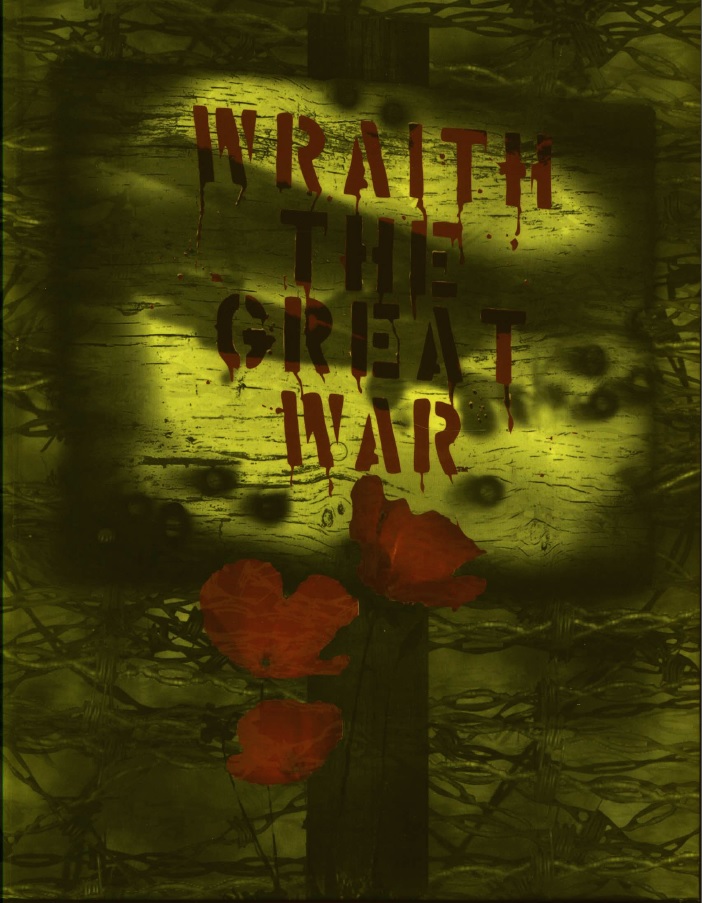
Introducing the book
I’m a big Wraith fan, and Great War is one of my favorite books in the line (Dark Kingdom of Jade is the other one). It’s a pretty well-written book (in my opinion), and it feels quite playable. There’s certainly a lot of conflicts players can invest themselves in from the get-go, compared to the more Sandbox approach of modern Wraith. Another reason I like it is because I’ve always been highly interested in the First World War. Before I failed out of college for the first time, I was studying to become an historian, and WW1 would have been my specialty. At 234 pages, it’s about twice as big as Charnel Houses. Hopefully the fact that I love the book a lot more will help me not laze out halfway through this time.
Before I start though, a big of context: What the hell is Wraith: the Great? Well, you have to go back to the late 90s, back when White Wolf was at the top of its popularity. One could argue that the late Second Edition to Time of Judgment was White Wolf’s Golden Age, with all kinds of wild experiments, innovation, great books, stuff like Trinity and Exalted, etc. Also a lot of terrible books, some of which have already been covered in this thread. Anyway, things were going pretty well for the World fo Darkness, so they decided to make spin-off games for all of their major WoD gamelines: historical settings. Vampire got Dark Ages (set during the late Middle-Ages instead), Werewolf got Wild West, Mage got Sorcerer’s Crusade (set during the Renaissance) and Wraith got The Great War (set during WW1). Unlike the other three games, Wraith didn’t get any supplements (even Wild West got four). Also a difference from the other three books: it’s not a full corebook. It’s a supplement, including only the rules that are changed for the era it covers, meaning you need the Wraith Second Edition Corebook in order to play the game.
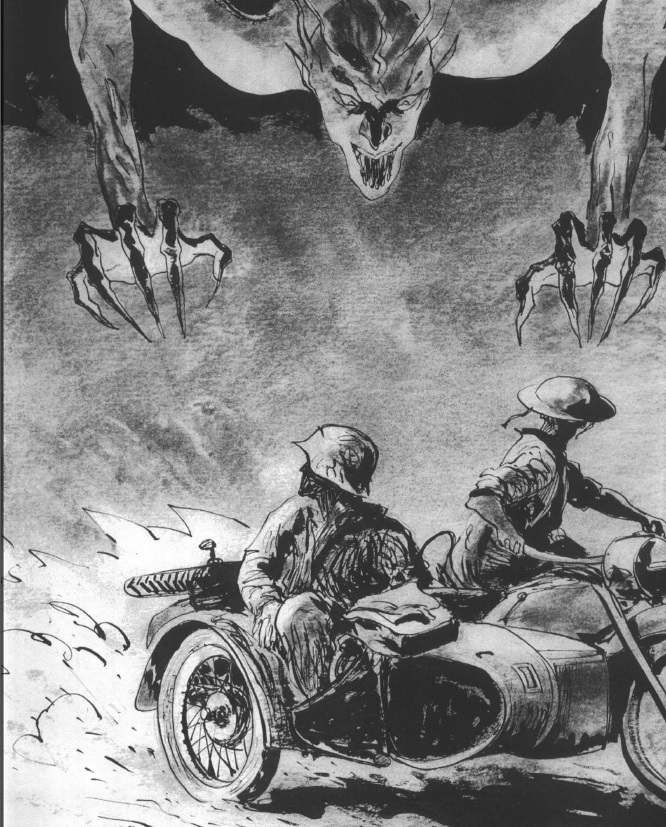
A smart man on a fast motorcycle can outrun the very winds of hell.
Intro Fiction: Waiting out the Storm
First off, before I start talking about the book, I have to mention that the art is pretty great. It’s not nice,
nothing
in Wraith is nice, but it’s extremely evocative.
The book starts, as usual with White Wolf books, with an introductory fiction. I think it’s pretty good, at least better than most WoD books. A messenger on a motorcycle is trying to reach the Brussels Necropolis before the Maelstrom hits. Unfortunately, he stops to help a new wraith on the way and, because of that, doesn’t reach the city before its gates are closed. So him and the kid hide from the storm in an old house with a mysterious old man. The messenger and the old man then explain to the new wraith what’s going on, a neat way of giving an overview of the setting to the player.
“There’s an Empire of the Dead that’s falling to pieces, and a hole at the heart of the world that wants to swallow everything. There’s a storm going on that’s been blowing for years and doesn’t look like it’s ever going to stop, and armies of the dead marching on each other.”
Here’s the gist of it: during the Battle of the Somme, a Great Maelstrom, one of the great tempests that ravages the lands of the dead and throw a shitload of Spectres at everything and lasts for years, started. Because of it, communications between Stygia and the rest of its Empire have become terrible, and travel is extremely dangerous. Then, the Smiling Lord (lord of those who died of violence) decided to attempt a coup. With Charon mysteriously absent, and his ranks welled by the war-dead, he was pretty successful at first. But there’s a resistance, the other Legions are organizing themselves, and the messenger’s part of it: he carries secret messages through the Storm. The kid leaves, and then the mysterious old man is revealed to be Charon in disguise. Apparently, he decided to take a good look at the Empire from the botoom, and figure out what he was doing and why. The rebellion was
“Not unanticipated, but not welcomed either.”
The story ends with the messenger getting back on his ghost motorcycle, ready to spread a bit of hope around.
Next time I’ll go over the Introduction, and try to explain the most confusing Wraith jargon.
Introduction
Original SA post
Here, have some more stuff about dead people.
Wraith: the Great War
Introduction
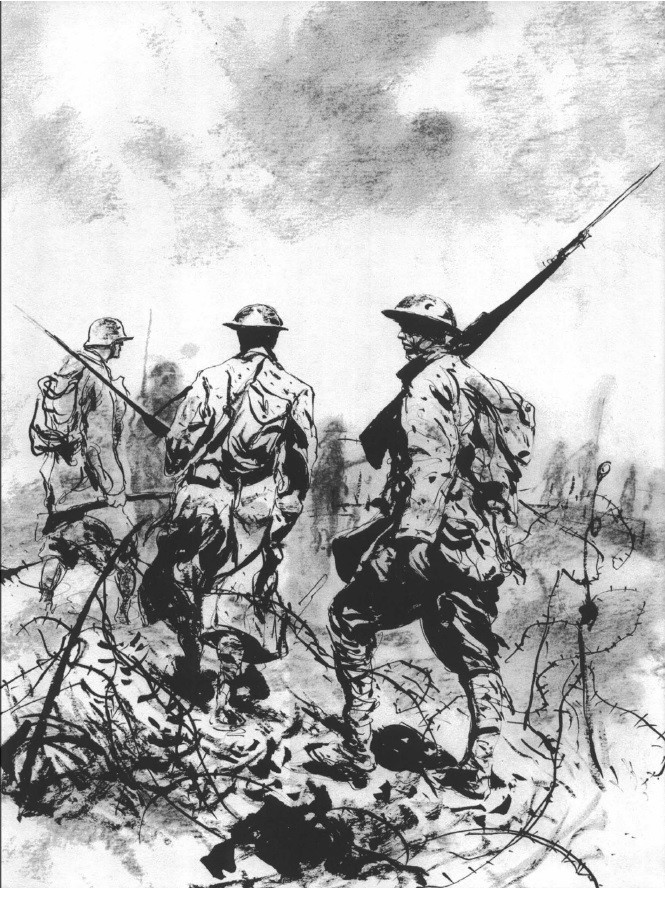
In classic White Wolf fashion, every chapter begins with a one-page story. The one before the Intro features a group of Renegades meeting to plan the liberation of London from the forces of the Smiling Lord. Nothing special.
Then we get the Introduction proper. A few paragraphs to set the tone and try to sell the setting (I must say I like the idea of a ghost Zeppelin myself), followed by the description of the book’s contents and a larger lexicon. The time period of Wraith: the Great, going from Armistice Day to the day right before the Great Crash, is known as the Twilight Era, the time period before the World of Darkness of the modern game. Since it’s a good way to catch up on a lot of the game-specific jargon, I’m going to repost most of the Lexicon, with only the ones I find stupid removed (like Seppuku: Really, Wraith, really?).
-
abambo
: A term for African ghosts
- Annals of Pestilence (aka Journals of Bone): a book containing the mad ramblings of the Skeletal Lord

- Benandati: a group of dudes who can see Ghosts and go to the Udnerworld. They’ve shown up in Wraith books before.
- Behest: An Arcanoi (ghost powers) used by African wraith
- The Beaufort-Granogrec Scale: A system for developing Maelstrom intensity. Ghost Science!

- The Black Mask: one of the many espionage orders of the Legions, this is the one of the Grim Legion
- The Bleak Legion: a Russian subset of the Silent Legion
- The Breathless Dead: ghost of Spanish Flu victims.
- The Bush of Ghosts: the African kingdom of the dead, also called the Dark Kingdom of Ivory
- Cataphractoi: the heavy cavalry of the Legion of Fate
- Displace: another new Arcanoi, this one is Indian in origin
- The Flesh Corps:
 An order of the Penitent Legion, who use giant moliated Leviathan to fight.
An order of the Penitent Legion, who use giant moliated Leviathan to fight.
- Fourth Great Maelstrom: the giant magic tempest that ravages the Shadowlands for the entire Twilgiht Era
- Generals of Oblivion: a powerful group of Spectre during this era
-
hun
: the “Of the East” term for the higher soul of a Wraith. Also used in Kindred of the East!
-
ibambo
: another African word for Wraith
- Imperialist: the “New Stygian” regime of the Grim Legion, the bad guys
- The Insurrection: The attempt by the Grim Legion to take over Stygia
- The Jade Kingdom: The Asian Deadlands [sic]
- Johnny Songbirds: a bunch of wandering bards
-
kuei
: “asian” word for Spectres
-
loka
: an Indian word for one level of the “upper worlds” of their afterlife. I have no fucking clue what this means right now.
- Loyalists: the other side of the Wraith civil War, those who oppose the Smiling lord.
- Maelstrom: evil magic tempest in the Underworld
-
Magisterium Veritatis
: the Stygian secret police
- Ministry of Intelligence: the espionage order of the Iron Legion
- Moriman: a “witch-doctor”, an African wraith for practices Behest
- Mutilé: a type fo spectre common during this era
-
Nawab
: Indian government official
- Night Mail: a group of aviators who try to keep communication lines between Necropolis open
- Night of Short Chains: When the Grim Legion seized Europe
- Ocean: the African word for the Tempest
- Office of Maelstrom Preparedness: wraiths dedicated to predicting and quelling the Great Maelstrom. More Ghost Science!

-
Peng Lai
: Jade Kigndom term for Paradise
-
p’o
: Jade Kingdom term for a Shadow
- Scavenger Folk: group of Wraiths of scavenge debris from the Maelstrom
-
Sinkinda
: Bush of Ghost term for Spectre
- Soulwelding: A variant of Soulforging used to maintain ghost vehicles
- Swar: the Deadlands of India
- Tvashtriya: practioners of Displace
- Uitlander: African term for strangers and white people
- Yellow Springs: Another alternate for the Dark Kingdom of Jade
Wow, that’s a lot of
 , and I cut a lot of useless ones (like “Yank” or “Huns”). Some of them won’t make sense until I go in-depth into the various factions. The chapter ends with recommendations of Books, Movies and Music to use as inspiration, something I always liked in White Wolf books. While the list obviously outdated (the book came out 15 years ago), I’d say it’s pretty good. It’s got Gallipolli, Paths of Glory, etc. The only movie I’d say is obviously missing is
La Grande Illusion
, a classic French movie about a prisoner escape during the war, dealing with the end of the ancient aristocratic ideals of war. It’s a pretty great movie, ire commend it to anyone interested in these kind of things. The music of Philip Glass is recommended, which should ensure everyone at the table is creeped out I guess.
, and I cut a lot of useless ones (like “Yank” or “Huns”). Some of them won’t make sense until I go in-depth into the various factions. The chapter ends with recommendations of Books, Movies and Music to use as inspiration, something I always liked in White Wolf books. While the list obviously outdated (the book came out 15 years ago), I’d say it’s pretty good. It’s got Gallipolli, Paths of Glory, etc. The only movie I’d say is obviously missing is
La Grande Illusion
, a classic French movie about a prisoner escape during the war, dealing with the end of the ancient aristocratic ideals of war. It’s a pretty great movie, ire commend it to anyone interested in these kind of things. The music of Philip Glass is recommended, which should ensure everyone at the table is creeped out I guess.
Next we’ll start the huge History section, a must-have for any historical game.
Part 1: History
Original SA post Wraith: the Great War Chapter One: War and ArtermathPart 1: History
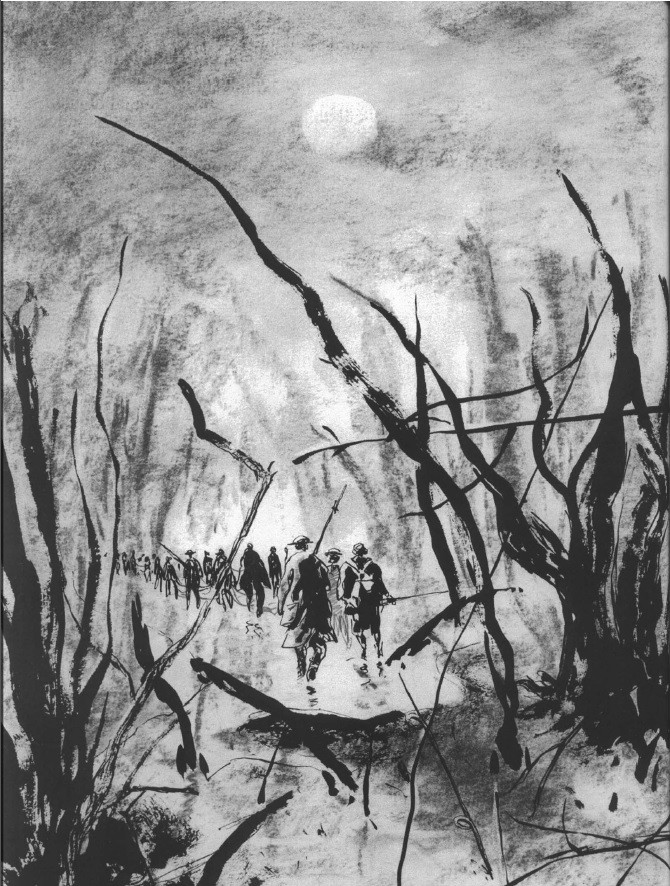
The intro fiction this time around focuses on a group of Wraiths forced to do Manual Labor by the Grim legion, and keeping tracks of insults for later revenge. Nothing special.
Four Years in the Skinlands
Futurist Manifesto, 1909 posted:
We intend to sing the love of danger. We will glorify war.
A decade among the dead
Seeds of the Stygian insurrection are sown almost a century earlier. In the 1820s, it is discovered that the Fetters of all the Deathlords and Charon have been destroyed. No one responsible is found, although various enemies of the State are blamed. Losing all your fetters is a very bad thing in Wraith: it makes it really hard to stay in the Shadowlands for long (later on the story will have Deathlords running around Shadowlands Europe without any problems, so this plotpoint seems useless in retrospect
 ) Following the Unfettering, Charon spends more and more time alone in his Onyx Tower, remaining out of the public eyes for years at a time. When WW1 starts, he hasn’t been seen for 9 years. This leads to a general emboldening of the Legion, many of which start stretching the limits of the
Dictum Mortuum
, the law that forbids interaction with the Skinlands. The most obvious is the formation of the Bloody Legion, a group set up by the Grim Legion to fight Necromancers. Take that, Giovanni!
) Following the Unfettering, Charon spends more and more time alone in his Onyx Tower, remaining out of the public eyes for years at a time. When WW1 starts, he hasn’t been seen for 9 years. This leads to a general emboldening of the Legion, many of which start stretching the limits of the
Dictum Mortuum
, the law that forbids interaction with the Skinlands. The most obvious is the formation of the Bloody Legion, a group set up by the Grim Legion to fight Necromancers. Take that, Giovanni!

Beautiful Stygia, a nice vacation spot
As more and more of the war dead pile up, a proclamation of dubious origin comes from the Onyx Tower, supposedly from Charon himself, calling for the construction of new towers to house the enw dead on the hills just outside the city walls. In Russia, a group of Bleak Legionnaires reap the ghosts of Japanese soldiers who died at Port Arthru in 1905 and keep them hidden, instead of handing them over to the Dark Kigndom of jade as per their agreements. Eventually, yu Huang learns of it and attacks the Russian wraiths, who manage to send their prisoners to Stygia by ghost train. Not knowing what to do, they set them up to building the towers. Angry Jade diplomats want their ghosts back, while Stygia asks for Russian wraiths reaped by the Jade Empire at Port Arthur in exchange. The talks then end.
A lot of Indian and African wraiths find themselves in Europe instead of their respective Deadlands, and tension between these poor exiles and the Stygian wraith grow daily. Then the Fourth Great Maelstrom hits during 1916. The original onslaught of Spectre take over Necropolis Florence, and Chicago becomes a chaotic battleground. Berlin and Paris manages to resist. Several months into the Storm, group of European and Indian wraiths arrive at Constantinople, apparently having had to walk through the Storm after having been forcefully expelled out of the Bush of Ghosts. Maybe one in ten managed to make it. Learning of the terror of the Storm, many of the Exiles planning on journeying to their homelands decide to indefinitely postpone their travel plans.
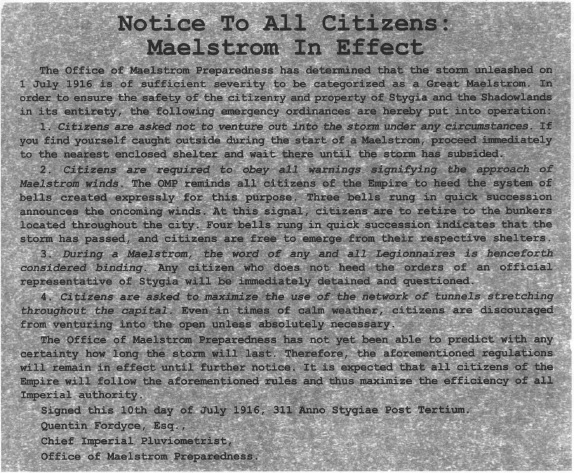
The Office of Maelstrom Preparedness, still the best at Ghost Science

Seeing the Hierarchy on the brink of collapse, Charon nowhere to be seen and afraid another Deathlord might attempt a coup before him, the Smiling Lord, leader of the Grim Legion, the Legion consisting of the dead of violence, hits all the major European Necropolis at once. Most leaders of the other Legions are captured, with those willing to cooperate left as figureheads. Thanks to the efforts of the Bloody legion, and his policy of letting soldiers avenge themselves on their incompetent officers, the Smiling Lord is initially pretty popular. The other legions are not particularly keen on letting the Smiling Lord become the “first among equals”, and so resist. The Iron legion 9dead of Old Age) are the hardest hit, with the Smiling Lord destroying their intelligence network in particular. The Laughing Lady (dead of madness) is forced to abdicate, but later escapes and become a figurehead of the Loyalists. The Emerald Legion (dead of accidents) side with the Grim Legion out of self-interest. The Legion of Fate (dead of destiny) and the Silent Legion (dead of despair) prefer to fight the Spectres, ignoring most of the conflict. The Legion of paupers (dead of mystery) manages to profit from the situation by doing mostly nothing… somehow. :shrug Finally, the Skeletal Legion (dead of pestilence) are the ones who resist the most strongly and effectively, contrary to the Smiling Lord’s expectations. Things go well initially for the insurrection: the only Necropolis they cannot take is Berlin, and the Berlin wraiths can,t really do much anyway because they’re too busy fighting the Spectres.
What no expected was the Spanish Flu. Early dead of the disease come out babbling prophecies, and are quickly taken by the Skeletal Legion and protected. There, the Skeletal Lord learns of the extent of the epidemic and starts planning accordingly. Part of the Smiling Lord’s plan to stay Imperator is to appear as the Strong Man needed to keep things going. This illusion is shattered when a group of Renegades manage to take over the Agora in Stygia and hold it against the Grim Legion for almost a full day. They don’t accomplish much, but the “Agora Dozen” shatter the image of the strong New Stygia and become folk heroes among the Loyalists.
As a consequence of the taking of the Agora, the Emerald Lord decides to switch sides, never being particularly taken with loyalty. The Loyalists grudgingly accept him, as they need his help against the Insurrection. Another consequence is that a Japanese wraith named Hirobumi Ito decides that now is the moment and free the Japanese wraiths held prisoner in “the Paper Cage”. The Skeletal Lord, having gathered his forces at Necropolis Madrid, attacks Lisbon and manages tot ake to the city for the Loyalists. At the key moment of the battle, his brandishing of Charon’s blade, Siklos, manages to convince even a large group of Grim Legionnaire to abandon their Deathlord and join the Loyalists. As a counter to that, and as part of a PR offensive, the Smiling Lrod declares he will not fight “petty rebels”, but the real enemy: Oblivion. He will liberate Florence. He fails: only a fifth of his army survives the brutal battle and makes it back to Stygia. The Skeletal Lord cannot capitalize on his enemy’s failure though, as it seems as if his alliance might come apart: one of the reasons he managed to take Lisbon was promising African wraiths the Lisbon Harbingers (users of the Arcanoi Argos, which is basically travel magic) would then ferry them to Africa. The Harbingers aren’t very keen on it, and tension quickly grows between European and African wraiths. Eventually, a group of harbingers agree to take one boat to the Bush of Ghost, carrying a maximum of 50 wraiths. There’s a lot of infighting to select the lucky ones, and when the boat is lost at sea many start to believe this was all a plan of the Skeletal Lord to break their community apart. The Skeletal Lord merely has the biggest migraine ever. Fed up with both of the Insurrectionists and Loyalists bullshit, Renegades are ever more popular across Europe, and Vienna declares itself an independent sovereign kingdom, and neither the Smiling Lord nor the Skeletal Lord can do anything about it… yet.
Wow, that was a lot of
 . Next time, we finish Chapter 1 with a look at all the various factions in this giant mess.
. Next time, we finish Chapter 1 with a look at all the various factions in this giant mess.